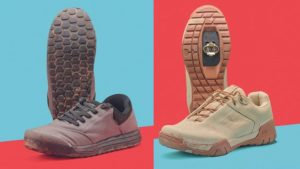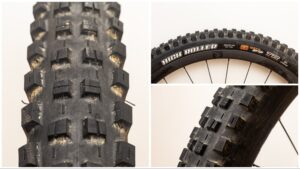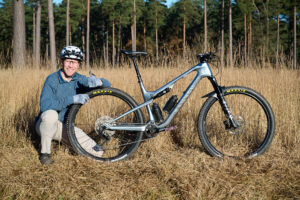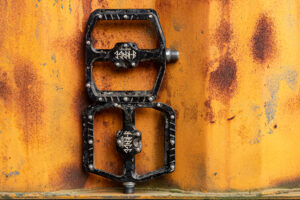The sub £100 price category is where you’ll find the best value helmets for trail and cross-country riding. Here are our experts' pick of the bunch.
The sub £100 price category is where you’ll find the best value helmets for trail and cross-country riding. Design details, construction methods and safety technology has rapidly made its way from premium-priced helmets to the more affordable models we’ve listed below.
In this guide you’ll find regular open-face helmets. If you’re looking for a full-face or convertible lid for bike park riding, enduro racing or gravity use, then check our guide to the best mountain bike full face and convertible helmets. Looking for an open-face trail helmet but have a higher budget? Check out our comprehensive guide to the best mountain bike helmets.

The Specialized Camber helmet is a sleek and polished design for not a lot of money.
1. Specialized Camber
Best value trail helmet under £100
Weight: 392g | Sizes: XS, S, M, L, XL | Rating: 9/10
Reasons to buy:
- Premium looks
- Excellent value for money
- Well ventilated
- 5 star Virginia Tech safety rating
Reasons to avoid:
- Non-adjustable peak
- Not the most stable helmet on rough terrain
- Padding lacks anti-bacterial treatment
One look at the Specialized Camber and you’d be forgiven for thinking it sits near the top end of the brand’s helmet lineup. With a refined finish, some slick colour options, MIPS safety tech, and a host of neat details, the Camber looks a compelling option for a trail helmet with a £70 price tag.
To hit this price point Specialized has made some compromises though. The Camber uses a single (rather than dual) density EPS construction and the MIPS SL liner is thicker and less refined than the ones used on Specialized’s premium helmets. The padding is kept to a minimum too – and doesn’t have any anti-bacterial treatment.
Although the peak isn’t adjustable, it’s designed to breakaway on impact and is integrated into the shell design to assist with venting. Specialized has also added space between the brow pad and shell to increase airflow but although the Camber has decent overall ventilation, it’s not class leading.
With five sizes available, the Camber should suit head sizes from 49-63cm, but we found the ratchet on Specialized’s Integrated Fit system lacked the fine adjustment found on pricer models – and the cradle sits a touch high too. In rough terrain, the Camber was not as stable as the other open-face helmets in our group test.
Read our full review of the Specialized Camber helmet

Troy Lee Designs helmets always fit great and look amazing, but until the Flowline came along, they commanded premium prices.
2. Troy Lee Designs Flowline MIPS
Most stylish helmet under £100
Weight: 355g | Sizes: XS/S, M/L, XL/XXL | Rating: 8/10
Reasons to buy:
- Scores well for stability and comfort
- 5 star Virginia Tech rating
- Low weight for a trail helmet
- Huge range of 11 colour options
Reasons to avoid:
- Average ventilation
- High price for the spec
Troy Lee Designs (TLD) is a brand with a focus solely on mountain bike and moto gear. This brand has produced some iconic lids over the years and the A3 trail helmet has been a go-to favourite for staffers at MBR, as well as scoring well in our reviews. The Flowline is TLD’s cheapest helmet and is offered in this standard version, or the more feature-rich SE model for an extra £40. Both Flowline models use a full-wrap shell, a MIPS liner and carry a 5 star Virginia Tech rating, along with the latest NTA 8776 (STD) e-bike pass.
The Flowline uses a similar shell silhouette to the iconic A3 helmet and, in typical TLD manner, is offered in a huge range of colour options. To keep the price below the £100 mark, the Flowline uses a simpler construction, with fewer vents and a single density EPS construction. TLD has trimmed the spec too – there’s a standard (not magnetic) buckle and no anti-bacterial treatment for the pads. However, step up to the pricier Flowline SE and you’ll find these features as standard. Troy Lee helmets always score well on fit and comfort and the Flowline is first class here, with the only average rating for ventilation and a high price tag (for the spec) letting it down.
Read our full review of the Troy Lee Designs Flowline MIPS helmet

Smith’s Engage MIPS helmet is a distinctive design boasting premium construction.
3. Smith Engage MIPS
Best trail helmet under £100 for premium finish and quality
Weight: 344g | Sizes: S, M, L, XL | Rating: 9/10
Reasons to buy:
- Premium finish and construction
- Stable in the roughest terrain
- Generously padded
Reasons to avoid:
- No magnetic buckle
- High price tag for the spec
Smith has built its reputation with high-spec helmets, usually with a price tag to match. The Engage was the first model below £100 in Smith’s helmet range – and inherits the styling, finish and neat details seen on the brand’s premium models.
The Engage is a helmet for trail riding, so it has a deeper rear for more coverage and a ‘full wrap’ shell to resist damage and keep it looking tidy. The peak is adjustable too, a feature that can be missing on helmets at this price point. Smith’s helmets always have a refined and well-finished feel and look and the Engage is no different – the slim, lightweight straps, the solid feel to the peak adjustment, and the lack of rough edges or wonky logos all shout premium quality.
The additional safety-boosting Koroyd technology used on Smith’s higher-priced helmets is missing from the Engage model (the newer Engage 2 does get this though), but it is equipped with a standard MIPS liner. Even though this Smith trail lid boasts 21 vents, we found it not as well ventilated as the best in this sub £100 class, although the padding is generous, aiding comfort in the heat. Overall, the Smith Engage scores very well, with stability, comfort and the premium finish being highlights that we feel justify the price.
Read our full review of the Smith Engage MIPS helmet

The Tactic 4 MIPS is another great value helmet from Specialized.
4. Specialized Tactic 4 MIPS
Best trail helmet under £100 for safety features and options
Weight: 385g | Sizes: S, M, L | Rating: 8/10
Reasons to buy:
- Solid and well-made for the price
- Great value
- Certified for electric mountain bike use
- Option to add Specialized’s ANGi crash sensor
Reasons to avoid:
- Limited fit adjustment for cradle height
- No peak adjustment
Now in its fourth generation, the Specialized Tactic 4 has been refined in all areas. Construction and finish are first class, there’s the option to add the brand’s ANGi crash sensor and it now passes the more rigorous e-bike NTA 8776 safety standard. The Tactic 4 also scores 5 stars in Virginia Tech’s lab tests, beating all other open face helmets on the market.
For a helmet aimed at trail and enduro riding, it may seem odd that the peak is not adjustable. It’s integrated into the shell (to boost ventilation) and, like the peak on Specialized’s cheaper Camber helmet, is designed to break away on impact. Another deviation from the norm is the dial for the ‘Integrated Fit System’, which is located in the base of the outer shell and tensions in the opposite direction to most helmets.
Specialized uses the MIPS Evolve liner on the Tactic 4. This has pads that are integrated into the liner itself – a step up from the standard model – but like many MIPS-equipped helmets our tester experienced some occasional creaking from this. Another niggle was with the rear fit cradle, which lacked adequate height adjustment and didn’t extend deep enough to reach underneath the occipital bone. Although we found a few complaints, the Tactic 4 really is an excellent trail helmet for the price, with a solid build and excellent safety credentials.
Read our full review of the Specialized Tactic 4 MIPS helmet

It might not be the ultimate statement in style, but the Abus Modrop MIPS Quin Helmet is a great choice for the money.
5. Abus MoDrop MIPS Quin
Best trail helmet under £100 for fit and stability
Weight: 365g | Sizes: S, M, L | Rating: 8/10
Reasons to buy:
- Excellent fit and adjustment
- Stays rock solid on the roughest terrain
- Comprehensive head coverage
- Fitted with Abus Quin alert chip
Reasons to avoid:
- Runs hotter than best-in-class trail helmets
- No magnetic buckle
Abus may well be relative newcomers to the trail helmet category but this MoDrop lid has plenty to offer. Designed for trail or enduro riding, the MoDrop helmet is offered in three versions – a basic model (without MIPS), a MIPS-equipped model, and this MoDrop Quin with MIPS and the Abus Quin emergency alert chip fitted. We tested the top spec model which has the same price tag as the Specialized Tactic 4 and the Troy Lee Designs Flowline helmets.
The MoDrop offers plenty of shell protection for its intended use, with substantial coverage at the temples, ears and nape of the neck. It has a deep fit, which is reassuring, and the height adjustable cradle has a dial with plenty of precision to get a secure fit. The padding is generous and plush, boosting comfort further, and our tester didn’t experience any hot spots or irritation.
With this level of comfort and coverage you’d expect to pay a weight penalty with the MoDrop, but at 365g for our medium test helmet it remains competitively light. The compromise we found was the ventilation, as we felt it ran a touch hotter than many of the trail helmets in this price category. It’s the only issue we had with the Abus MopDrop, which otherwise offers a first class fit and class-leading stability in rough terrain.
Read our full review of the Abus MoDrop MIPs Quin helmet

Here at MBR, our testers have decades of experience testing helmets.
How we test the best mountain bike helmets under £100
Just because these helmets sit below £100 it doesn’t mean we review them in a different way. MBR’s product testers have been evaluating and reviewing helmets for decades, following the steady evolution of design details and safety tech, along with the arrival of new product categories and rider needs.
All new mountain bike helmets need to pass the current CE testing. This means helmets must meet certain fixed test criteria like impact velocities, roll-off tests, and strap system strengths. This is a minimum requirement and plenty of newer helmets surpass these by incorporating composite materials into sub frames, or additional tech for extra protection. Many of the best helmets tested now carry a safety rating from Virginia Tech and meet the more rigorous e-bike NTA 8776 safety standard.
These tests evaluate the helmet itself, but getting the correct fit plays an important part in protecting your head in an impact as well as contributing to ride comfort and stability.
When we test helmets we consider shape and head coverage, sizing, fit, stability, comfort, adjustability and ventilation. We use previous test-winning helmets as benchmarks and ride in a wide range of weather conditions, across a variety of terrain to thoroughly evaluate each model.

A good budget helmet has to be safe, but also look good, to motivate you to wear it.
What to look out for in the best budget helmets
Regardless of what terrain you ride or the clothing you choose to wear, you’ll need a helmet for proper mountain biking. A trail helmet is a key piece of safety equipment, which along with a pair of the best mountain bike gloves should be a priority. A helmet has a real-world lifespan too, with many brands recommending replacement after 3 years of regular use, so if your current lid is looking tatty and sporting marks from knocks and scrapes, then it’s worth considering a replacement.
The good news is that year-on-year we are seeing helmet design evolve rapidly. Modern trail lids use refined fitting systems, smarter details and more comprehensive coverage – all without an increase in weight. As the best trail mountain bikes become more capable, taking you into more challenging terrain, these up-to-date helmets will remain stable on your head, play well with the best goggles or best riding glasses and keep you cool on long, hot rides. An added bonus is most don’t compromise on the styling and are hard to distinguish from top-of-the-range models.

This Troy Lee Designs A3 helmet gets lots of bells and whistles, but at its core, the most important features can be found on a budget helmet.
Key features of the best mountain bike helmets under £100
For under £100 you can now get a no-compromise mountain bike helmet that’s purpose-built for trail riding. Step up from a budget, entry-level helmet and you’ll find design details that only a few years ago were reserved for a brand’s premium-spec lids.
Below we run through the key features to look for on the best trail helmets under £100.

A hard shell protects the EPP and EPS energy absorbing material from knocks.
Shell design and material
A modern trail helmet boosts protection by covering more of your head. These helmets aren’t a road helmet with a peak, they are a ground-up design with a focus on trail rider’s needs.
You’ll find a more rounded, less ‘aero’ shape, with a deeper rear shell running down to the nape of your neck. The sides and brow area often see added material too. The result of this shell shape and additional material is more of the helmet is in contact with your head, which may mean a slightly warmer helmet but it does contribute to better stability.
All of the helmets tested uses an EPS (expanded polystyrene – a lightweight and rigid foam material) construction, with an in-moulded microshell to reduce dents and dings and increase the helmet’s lifespan. Under £100, most trail helmets we’ve tested use a single-density EPS construction but increase your budget and you’ll find models with dual-density construction and additional safety tech such as Koroyd (Smith and Endura) and WaveCel (Bontrager).

The twist-to-fit adjustment allows you to tailor each size to your head.
Helmet sizing
As mentioned above, sizing is a key contributor to the overall safety and effectiveness of your helmet – it needs to stay in place in an impact to protect you.
Most helmets are offered in a selection of single sizes (S, M, L etc) but you may find models split over two sizes (S/M, L/XL etc). However the brand sizes its helmets, each will refer to a measurement range, usually in cm. If you’re ordering online – and can’t try before you buy – you’ll need to measure your head circumference at its widest point to determine your size. Use a soft measuring tape or a piece of string that you can take a measurement from.
A helmet will be designed to accommodate a size range as it will use a retention system (see below) to fine-tune the fit to your head size. For a perfect fit – with no hot spots or unnecessary movement – you’d ideally be somewhere in the middle of the sizing range. Helmet shapes vary too, which can impact the fit, so if one model isn’t ideal for your head, try a different design or brand.

Giro was one of the first brands to introduce an adjustable cradle/retention system for your head.
Retention system
Helmets are equipped with a retention device allowing you to adjust the fit to your head size. They cradle your head, usually starting at the brow and ending with a dial that sits at the helmet’s rear, below the outer shell. Adjusting the dial will tension the band and fine-tune the fit, although some systems have larger jumps between each click than others, which will impact the precision.
Where the cradle and dial sits on the rear of your head (and in relationship to your occipital bone) can play a part in comfort and fit. Many retention systems have height adjustment to accommodate different skull shapes and if your helmet has this then take advantage of it. Often, a helmet’s retention device will be designed to allow for a pony tail hairstyle to be worn comfortably, without compromising the fit.

The MIPS logo is a common sight on high-end helmets and offers increased protection against rotational injuries.
MIPS (and other safety tech)
Multi-directional Impact Protection System (MIPS) is a patented protective helmet liner that’s designed to slide when your head impacts the ground at an angle. This reduces the force of the impact and likelihood of a concussion or brain injury.
MIPS is a branded third party product, so several manufacturers make their own proprietary versions, each carrying its own name and used exclusively on that brand. When it was launched, MIPS was only found on high-end helmets but this tech is now more affordable and found on trail lids well below £100.

Ventilation and moisture wicking pads are important elements of the heat management.
Ventilation
Good ventilation is important on a trail helmet, especially for long rides in hot weather. Effective cooling of the head is a result of good airflow through the helmet and a high number of vents. The placement, angle and shape of the vents are all contributors to the overall ventilation and how the peak integrates with them is important too. Integrated peaks (such as on the Specialized Camber and Tactic 4 helmets) are designed to boost airflow into the vents.
The best-ventilated helmets use additional vents, sitting between the brow pad and the helmet shell, to draw air into the internal channels to boost cooling.

Magnetic Fidlock strap buckles make doing up your helmet simple and fast.
Straps and buckle
Straps are now lighter and thinner, giving higher comfort levels, easier adjustment and quicker drying speeds, without compromising the safety of the helmet. Plastic sliders or clips, sit below the ears, allowing you to manage the strap placement – a key part of getting the correct fit.
The main strap buckle – sitting below your chin – will be a regular ‘clip’ style buckle or a magnetic type. Both are proven and reliable. A magnetic buckle is often found on a higher priced helmet, with its main advantage being that just one-hand is needed to release it.
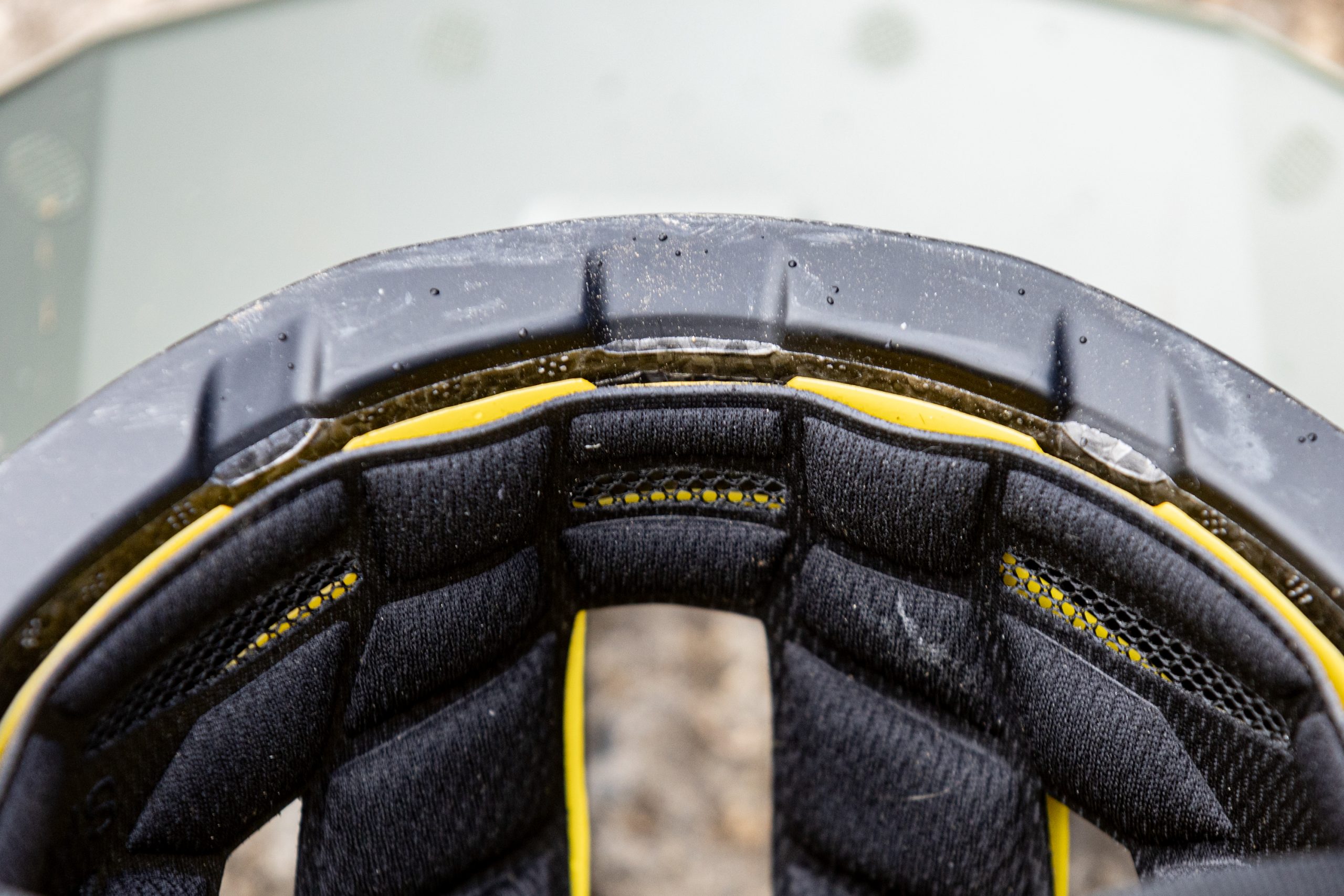
Most helmet padding is now anti-bacterial and sometimes uses a wicking fabric to help keep. you cool.
Padding
Most helmet designs use low profile padding that aids comfort and is placed so it doesn’t compromise airflow and cooling. Well-designed pads may be contoured to boost comfort, with channels to increase drying speeds. Thicker pads will run touch warmer but heavy-sweaters may find them more effective in the heat.
Ideally the padding will be a one-piece design (so it can be easily removed for cleaning) but you may find a separate brow pad. The best helmets use an anti-bacterial treatment to boost short-term hygiene.

Helmet peak’s can be fixed or adjustable for angle.
Peak/visor
A peak (or visor) will be standard fitment on all trail helmets. An adjustable peak means it doesn’t block your vision when riding with your head down and you can fine-tune it to deal with glare from the sun or heavy rain. Most adjustable peaks are ‘indexed’, clicking into position. We check the stability of the peak (and the effectiveness of its fixings) when we test helmets – a peak needs to stay in position on the roughest terrain.

Some helmets let you rotate the peak up and out of the way to ‘park’ a pair of goggles beneath on the climbs.
Goggle strap and parking
An adjustable peak also allows you to park your goggles underneath – when climbing or at rest. If a trail helmet has a focus on goggle use it may have a channel or gutter round the back to keep the strap in place. Alternatively a rubber/silicone panel or clip will be used.








